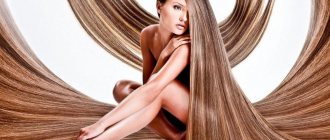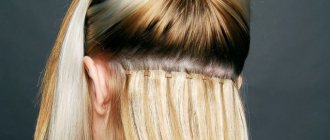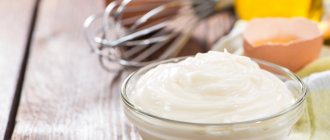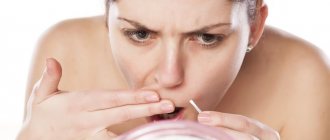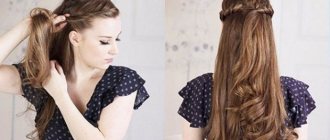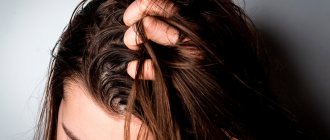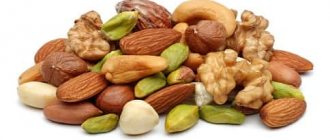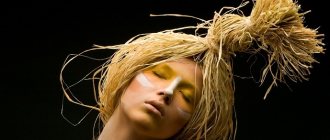Everyone knows how to wash your hair correctly: first you need to wet your hair, squeeze a little shampoo from the tube into your palm, apply it to the scalp with massaging movements, distribute it over the entire length of the hair, then rinse off the foam thoroughly. After shampoo, don’t forget about conditioner or balm - it’s best to leave such products on your hair for a couple of minutes and then rinse.
Every day, many people wash their hair the old-fashioned way, as they say, without thinking that today there are completely new ways to cleanse their hair. We will tell you about the most popular and effective ones.
Co-washing
And now we will talk about the most common hair washing, but not with shampoo, but with conditioner. African-American women invented this method of caring for their curls: by giving up shampoo, they were finally able to tame their unruly, coarse hair. First, rinse your hair thoroughly with water, it should be wet. Then apply the conditioner sparingly with massaging movements along the entire length. Take your time; the procedure should take at least five to seven minutes for the hair to be completely clean. It will also take a long time to wash off the conditioner. Many people recommend using this method for emergency hair moisturization.
Co-washing – a new word in hair washing
We are used to washing our hair with shampoo. It cleanses the hair and scalp well of fat and dirt, but can be harmful to the hair. Traditionally, many shampoos contain the following active substances: sulfates, foaming agents, silicones, parabens...
- Sulfates are responsible for cleansing curls, but they do it quite roughly, leaving the strands dry.
- Silicone seals the hair scales, which makes them smooth to the touch, but prevents the strands from breathing.
- Parabens (preservatives) are ballast substances that do not bring any benefit to the hair.
Sulfates, parabens, and other harmful components gradually accumulate outside and inside the hair.
What do we have in practice? Thin, dry strands become lifeless and brittle. The scalp becomes dry, which disrupts the functioning of the sebaceous glands. Curls quickly lose volume and become greasy in 1-2 days. That is why many people use natural soap, herbal infusions, and soap nuts instead of shampoos. Or use special detergents that do not contain sulfates, parabens, or silicones.
What is co-washing and what are the benefits of it?
Recently, a new trend in hair washing has been rapidly gaining popularity - Co-Washing. This term was formed from two words: conditioner (only) washing - washing hair with conditioner. The purpose of cowashing is to maintain the required level of moisture in the hair.
Cowashing owes its popularity to Lorraine Massey, an enthusiast in curly hair care. She herself is the owner of curls and therefore deals with this issue with great interest.
Curly hair is more prone to dryness than straight hair. Natural fat produced by the subcutaneous glands often does not reach the ends of the strands. The ends of the hair are deprived of proper nutrition and hydration, and shampoo further worsens their condition. To cleanse curls and curls, a softer and more gentle product is required.
Lorraine Massey believes that a good conditioner can and should be used instead of shampoo. The detergent components contained in the conditioner will easily rid your hair of dirt, grease, and dust. In addition, this product softens and moisturizes hair, and well-moisturized hair does not split or break. They hold volume, radiate a healthy shine and do not become greasy for a long time. Co-washing is a godsend for those with colored curls, since the conditioner practically does not wash out the dye.
Co-washing - washing your hair correctly
Cosmetics manufacturers quickly responded to the new trend in hair washing. Conditioning Cleanser
is the most advanced product for cowashing.
It uses additional cleansing ingredients of natural origin. The conditioner rinses the hair perfectly and moisturizes it well. Well-known professional brands that have co-washing products include Matrix and Kerastase.
There are no exact instructions for the cowashing procedure yet. You should focus on your own feelings and results. To make it easier to choose a washing mode using the co-washing method, its popularizers give general advice:
- Alternate cowashing with traditional hair washing. For example, one time you use only conditioner, and the next time you wash your hair with shampoo. Only it should be a special shampoo without silicones, sulfates, or parabens.
- Use regular conditioner after shampooing or cleansing conditioner. It will soften the strands, make it easier to comb, and moisturize your hair if you feel it has become too dry.
- Don't get carried away. Excessive moisture will make the hair structure porous and lead to brittle strands.
Washing your hair with (cleansing) conditioner has its own characteristics.
Wet the strands well. Distribute conditioner from roots to ends. Rub the product in for 5 minutes, remembering to massage your scalp thoroughly. Rinse your hair thoroughly with warm water. This is necessary because the strands have absorbed a large amount of the product. The periods of alternation between cleansing conditioner and shampoo are up to you. Their duration depends on the type of hair and its sensitivity to the components of cosmetic products. Over time, you will have to wash your hair less often, as co-washing normalizes the functioning of the sebaceous glands.
Proper drying of hair is no less important. No hair dryers! Let your hair dry naturally. You can use a towel, just don’t pull your hair with it, but gently blot it. Wet strands already put stress on the hair roots, which weakens the hair follicles.
Co-washing: disadvantages and contraindications
The co-washing method has two noticeable disadvantages.
- It takes at least twice as long to use it compared to regular shampooing.
- You use a lot of cleansing conditioner on your hair. Considering the cost of this product and the volume of standard bottles, the method is not particularly economical.
The problem with choosing the right product can, with some stretch, also be attributed to the disadvantage of cowashing. Even those shampoos and conditioners that, according to the manufacturer, do not contain harmful additives may contain them, but only under different names. You will have to read labels carefully before purchasing hair wash products.
- Heavily contaminated hair will need to be washed with a natural-based product before cowashing. The same rule applies if before the procedure you washed your hair with shampoos containing silicone and sulfates.
- Don't get carried away with cowashing if you have oily hair.
- Cowashing should not be used for scalp diseases.
- The procedure can harm weakened hair, exhausted by chemicals and styling.
Everything is good in moderation. Cowashing is a gentle and environmentally friendly way to care for your hair. But still this method is not universal. However, the procedure of washing your hair with conditioner, used from time to time, can significantly improve the condition of your hair and scalp.
Healthy scalp
Beautiful and strong hair depends 90% on the health of the scalp. And this means that it’s worth taking care of first of all if your hair suddenly - you haven’t noticed this before - begins to fall out or get tangled. Typically, girls encounter problems unusual for their hair type in the spring, when the scalp tries to “come to its senses” after winter shocks such as hats, heating and weather conditions with snow and wind. So if you are one of the latter, try giving yourself a quick course of cowashing (keeping the conditioner on your hair for 5 to 10 minutes before rinsing it off) - and you will immediately notice the changes.
Treatment frequency
The hair washing regimen is built depending on the hair type, lifestyle and climatic conditions. If you wash your hair in the morning and then go to the gym after work, co-washing can be done after your workout to refresh your hair without over-drying it.
If you shower in the evening, try using a cleansing conditioner and wrapping your hair in a bun at night to let the product work deeper before styling in the morning.
If your line of work requires you to shower several times a day, co-washing will also help avoid excessive harmful effects of shampoo.
If you live in a humid or foggy climate, you should shampoo more often and co-wash less often; in drier climates, the opposite is true.
If, for example, you wash your hair every 2-3 days, you should try co-washing on the weekends and limit your shampoo use to 1-2 times a week. If you wash your hair infrequently and without side effects, you can completely switch to co-washing.
If you feel your curls feel heavy or your strands are oversaturated with conditioner, you need to wash your hair with your usual shampoo.
Raw chicken eggs
chicken eggs instead of shampoo for washing hair are used quite often
The most commonly used is regular yolk. It is an excellent natural conditioner for curls and strands, providing them with essential minerals, vitamins and proteins. It is included in a large number of nourishing hair masks and helps improve the overall condition of the hair.
Washing your hair with egg instead of shampoo is very simple. It is enough to use it only once every 3-4 days, like an air conditioner after a regular shower. There is no need to use soap or other auxiliary products. In just a couple of weeks you will be able to see amazing results. Hair will become more manageable, fluffy and shiny.
Who is prewashing suitable for?
Western hair experts joke: everyone who has hair! But let's figure out for whom this method will really become a lifeline.
- Hair that is frequently permed, straightened, dyed, or complexly styled with super-strong hold
. Such hair vitally needs a dose of a nutritional “cocktail”. - Any long hair
. The ends of long hair always do not receive proper moisture, which is why they break off and split. So if you're looking to grow, pay as much attention to the length as you do to the roots. - Hair exposed to chlorine in the pool, sea water
, and
solar radiation
. Prewashing in this case will save you from overdrying. - For those who wash their hair every day
and daily expose their hair to excessive “bulging” of the cuticle. - Fragile and brittle
hair that simply needs such protection.
of long-lasting and deep-penetrating oil masks will also become fans of prewashing.
, which are aged for 2-4-8 hours or left overnight. Such masks are perfectly absorbed by the natural proteins inside the cortex and seal the inner layer, making it less prone to swelling in water.
What does cowashing do?
The experience of co-washing cannot be expressed in words: women consider this hair transformation to be magical, because it becomes livelier, more flexible and thicker. Technically, the procedure for washing hair without shampoo looks like this:
- the hair is divided into four equal parts;
- The conditioner is squeezed into the palm of your hand and rubbed into the scalp and strands, then distributed with massage movements for several minutes. However, each brand offers additional instructions on the product tube;
- The conditioner is washed off with water, like regular shampoo.
What can prevoching do?
To appreciate the significance of a modern method of hair care, it is necessary to take a short digression and understand how the hair itself is structured and how exactly it reacts to traditional water treatments. Let's start with the fact that hair has a complex three-layer structure:
- The first layer, the medulla
, is the inner shaft of the hair, responsible for its thermoregulation, volume and strength (in a sense, it is its fuel); - The second layer - cortex
- is a complex of woven protein threads (keratin fibers) responsible for the elasticity, strength and pigment of the hair; - The third top layer - the cuticle
- includes 6-12 layers of scales, glued together with a lipid layer, in other words, fat, which is produced by the sebaceous glands. It is the fatty layer of the cuticle that is able to retain moisture and act as a natural protective balm-conditioner.
It would seem so great, nature will take care of everything itself better than any means... But it’s not so simple!
The fact is that hair (meaning what grows above the surface of the scalp) is already inanimate matter, the metabolism in it is stopped, and therefore, complete restoration of the structure is simply impossible. The older the hair is, that is, the further it moves away from its “birth nest”, the less lipids remain under the cuticle scales, thus the protective layer becomes thinner, and the hair becomes drier.
With regular shampooing, hair length dries out even faster. Once in an alkaline environment, under the influence of detergent surfactants, the cuticle scales swell, rise, and vital fat (protective lipid layer) is gradually washed out of them, which subsequently cannot always be replenished even with the most expensive and nourishing mask.
Prewashing helps to avoid losses and prevent damage to the protective layer.
The most important feature of prewashing is that it seals moisture inside the hair before it is stressed during the washing process and loses that moisture. How to prevent this? There is no secret technology in prewashing.
What happens if you use 2 methods at the same time?
That is, give your hair a real conditioning party?
Overly dry and damaged hair may really appreciate this boost of care. But since cowashing in itself is a delicate procedure, preventive procedures are not needed here, otherwise you risk weighing down your hair and getting the effect of an unwashed head.
So, prewashing is not a new procedure, but it is very effective. Always remember that regrown hair requires special protection. You can endlessly nourish your roots with oils and growth-accelerating masks, but a miracle will not happen if your length breaks off mercilessly.
You need prewashing if you:
- You wash your hair frequently or daily and have long/medium length hair.
- Use a hair dryer, straightener, curling iron and styling products with strong hold.
- Dye your hair or perm/straighten it.
- Grow your hair long.
- We are sure that your hair is dry, brittle, brittle and damaged.
Author: Maria Shchukina, head of trends.
If you liked this article, don't miss:
- The strange beast “cowashing” or how to wash your hair without shampoo
- What happens to your hair if you don't use conditioner after shampoo?
- 8 trends in natural cosmetics
- TOP 20 natural shampoos
